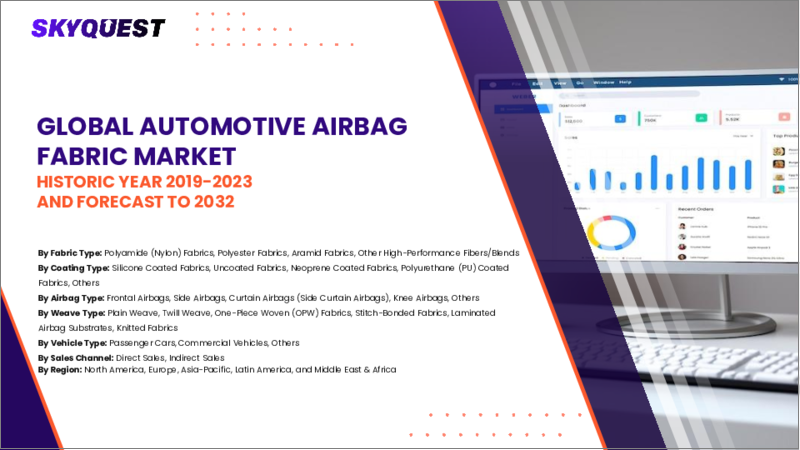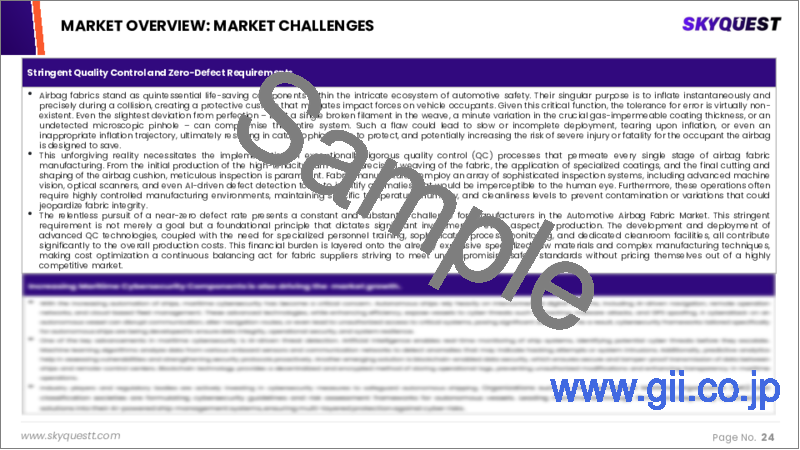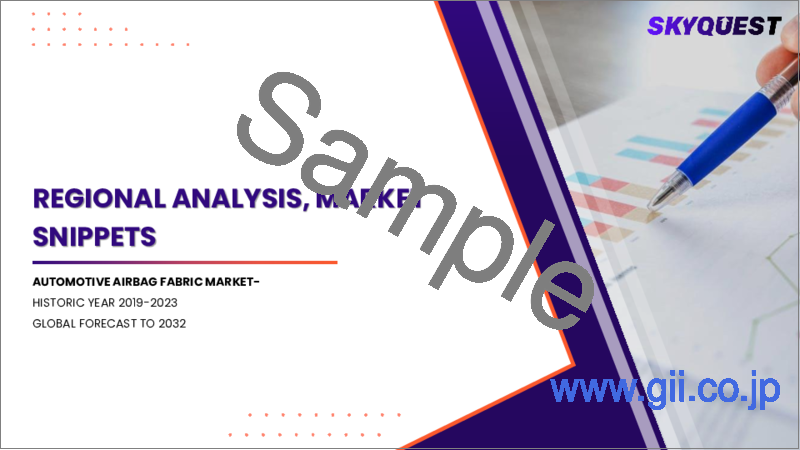|
|
市場調査レポート
商品コード
1636852
自動車用エアバッグ生地の市場規模、シェア、成長分析:エアバッグタイプ別、車両タイプ別、コーティングタイプ別、糸タイプ別、地域別 - 産業予測 2025~2032年Automotive Airbag Fabric Market Size, Share, Growth Analysis, By Airbag Type (Front Airbag, Side Airbag), By Vehicle Type (Passenger Cars, Light Commercial Vehicles), By Coating Type, By Yarn Type, By Region - Industry Forecast 2025-2032 |
||||||
|
|||||||
| 自動車用エアバッグ生地の市場規模、シェア、成長分析:エアバッグタイプ別、車両タイプ別、コーティングタイプ別、糸タイプ別、地域別 - 産業予測 2025~2032年 |
|
出版日: 2025年01月16日
発行: SkyQuest
ページ情報: 英文 350 Pages
納期: 3~5営業日
|
全表示
- 概要
- 目次
自動車用エアバッグ生地の世界市場規模は2023年に36億米ドルと評価され、2024年の38億3,000万米ドルから2032年には63億5,000万米ドルに成長し、予測期間(2025-2032年)のCAGRは6.5%で成長する見通しです。
世界の自動車用エアバッグ生地市場は、政府や自動車安全団体の厳しい安全規制によって大きな成長を遂げています。メーカーがエアバッグ生地の強度、耐久性、性能を高めるための研究開発に注力しているため、生地技術の継続的な進歩が不可欠です。革新的な織物素材、織物技術、コーティングが開発され、引き裂き抵抗性、エアバッグの効率性、軽量性を維持しながら費用対効果を向上させています。エアバッグは事故時にドライバーと乗員を保護するために不可欠であり、その性能はナイロン6,6やアラミド繊維のような先端素材に大きく依存しています。生地の主な特性には、高い引張強度、低い通気性、耐疲労性などがあり、エアバッグ用生地市場は自動車の販売や製造動向と密接に結びついています。
目次
イントロダクション
- 調査の目的
- 調査範囲
- 定義
調査手法
- 情報調達
- 二次データと一次データの方法
- 市場規模予測
- 市場の前提条件と制限
エグゼクティブサマリー
- 世界市場の見通し
- 供給と需要の動向分析
- セグメント別機会分析
市場力学と見通し
- 市場概要
- 市場規模
- 市場力学
- 促進要因と機会
- 抑制要因と課題
- ポーターの分析
主な市場の考察
- 重要成功要因
- 競合の程度
- 主な投資機会
- 市場エコシステム
- 市場の魅力指数(2024年)
- PESTEL分析
- マクロ経済指標
- バリューチェーン分析
- 価格分析
自動車用エアバッグ生地市場規模:エアバッグタイプ別& CAGR(2025-2032)
- 市場概要
- フロントエアバッグ
- サイドエアバッグ
- 膝エアバッグ
- カーテンエアバッグ
- その他のエアバッグ
自動車用エアバッグ生地市場規模:車両タイプ別& CAGR(2025-2032)
- 市場概要
- 乗用車
- 小型商用車
- 大型トラック
- バス
- コーチ
自動車用エアバッグ生地市場規模:コーティングタイプ別& CAGR(2025-2032)
- 市場概要
- ネオプレンコーティング
- シリコンコーティング
- コーティングなし
自動車用エアバッグ生地市場規模:糸タイプ別& CAGR(2025-2032)
- 市場概要
- ポリアミド
- ポリエステル
自動車用エアバッグ生地市場規模:地域別& CAGR(2025-2032)
- 北米
- 米国
- カナダ
- 欧州
- ドイツ
- スペイン
- フランス
- 英国
- イタリア
- その他欧州地域
- アジア太平洋地域
- 中国
- インド
- 日本
- 韓国
- その他アジア太平洋地域
- ラテンアメリカ
- ブラジル
- その他ラテンアメリカ地域
- 中東・アフリカ
- GCC諸国
- 南アフリカ
- その他中東・アフリカ
競合情報
- 上位5社の比較
- 主要企業の市場ポジショニング(2024年)
- 主な市場企業が採用した戦略
- 市場の最近の動向
- 企業の市場シェア分析(2024年)
- 主要企業の企業プロファイル
- 会社概要
- 製品ポートフォリオ分析
- セグメント別シェア分析
- 収益の前年比比較(2022-2024)
主要企業プロファイル
- Asahi Kasei Corporation(Japan)
- Toray Industries, Inc.(Japan)
- Toyobo Co., Ltd.(Japan)
- Kolon Industries, Inc.(South Korea)
- Teijin Limited(Japan)
- HMT(Xiamen)New Technical Materials Co., Ltd.(China)
- Global Safety Textiles(Germany)
- Indorama Ventures Public Company Limited(Thailand)
- Hyosung Advanced Materials(South Korea)
- Autoliv Inc.(Sweden)
- Toyota Boshoku Corporation(Japan)
- Safety Components International, Inc.(USA)
- Milliken & Company(USA)
- Ube Industries, Ltd.(Japan)
- Kordsa Teknik Tekstil A.S.(Turkey)
- SRF Limited(India)
- Century Enka Limited(India)
- XMT Materials(China)
結論と推奨事項
Global Automotive Airbag Fabric Market size was valued at USD 3.6 billion in 2023 and is poised to grow from USD 3.83 billion in 2024 to USD 6.35 billion by 2032, growing at a CAGR of 6.5% during the forecast period (2025-2032).
The global automotive airbag fabric market is experiencing significant growth, driven by stringent safety regulations from governments and automotive safety organizations. Continuous advancements in fabric technology are essential as manufacturers focus on R&D to enhance airbag fabric strength, durability, and performance. Innovative textile materials, weaving techniques, and coatings are being developed to improve tear resistance, airbag efficiency, and cost-effectiveness while maintaining low weight. Airbags are vital for protecting drivers and passengers during accidents, and their performance relies heavily on advanced materials like Nylon 6,6 and aramid fabrics, the latter being reserved for niche applications due to higher costs. Key fabric attributes include high tensile strength, low air permeability, and fatigue resistance, making the airbag fabric market closely tied to vehicle sales and manufacturing trends.
Top-down and bottom-up approaches were used to estimate and validate the size of the Global Automotive Airbag Fabric market and to estimate the size of various other dependent submarkets. The research methodology used to estimate the market size includes the following details: The key players in the market were identified through secondary research, and their market shares in the respective regions were determined through primary and secondary research. This entire procedure includes the study of the annual and financial reports of the top market players and extensive interviews for key insights from industry leaders such as CEOs, VPs, directors, and marketing executives. All percentage shares split, and breakdowns were determined using secondary sources and verified through Primary sources. All possible parameters that affect the markets covered in this research study have been accounted for, viewed in extensive detail, verified through primary research, and analyzed to get the final quantitative and qualitative data.
Global Automotive Airbag Fabric Market Segmental Analysis
Global Automotive Airbag Fabric Market is segmented by Airbag Type, Vehicle Type, Coating Type, Yarn Type and Region. Based on Airbag Type, the market is segmented into Front Airbag, Side Airbag, Knee Airbag, Curtain Airbag and Other Airbags. Based on Vehicle Type, the market is segmented into Passenger Cars, Light Commercial Vehicles, Heavy Trucks, Buses and Coaches. Based on Coating Type, the market is segmented into Neoprene Coated, Silicone Coated and Uncoated. Based on Yarn Type, the market is segmented into Polyamide and Polyeste. Based on Region, the market is segmented into North America, Europe, Asia Pacific, Latin America and Middle East & Africa.
Driver of the Global Automotive Airbag Fabric Market
The global automotive airbag fabric market is significantly influenced by the rising demand for electric vehicles (EVs). As manufacturers pivot towards electric vehicle technologies, major original equipment manufacturers (OEMs) are ramping up investments to enhance their production capacities. For instance, Ford has committed $11 billion towards EV development, with plans to introduce 40 new models by 2022. Similarly, Volkswagen AG aims to invest approximately $66.3 billion over the next five years, planning to launch 75 all-electric vehicles and 60 hybrids. Additionally, MG Motor's $1.5 billion investment in India exemplifies this trend. This growing consumer interest in EVs is expected to create substantial growth opportunities for the automotive airbag market, subsequently boosting the demand for airbag fabrics throughout the forecast period.
Restraints in the Global Automotive Airbag Fabric Market
The Global Automotive Airbag Fabric market faces significant restraints, primarily due to the high costs associated with airbag systems. The expensive nature of airbags presents a considerable barrier to market expansion, as these systems increase the overall price of vehicles. For budget-conscious consumers, particularly in emerging markets where affordability is crucial, the rising expenses related to airbags can deter purchases. This financial burden may limit accessibility for many potential buyers, thereby impacting the growth potential of the automotive airbag fabric sector and restricting its overall market dynamics.
Market Trends of the Global Automotive Airbag Fabric Market
The Global Automotive Airbag Fabric market is experiencing significant growth, driven by heightened passenger safety concerns and evolving automotive technologies. With the industry focusing increasingly on advanced safety features, the demand for innovative airbag solutions is surging, fueled by stricter regulations and consumer awareness. As manufacturers scale up production capacities to meet the growing requirements of airbags in vehicles-particularly in autonomous and connected car sectors-this segment is witnessing exponential expansion. Additionally, the proliferation of airbags per vehicle, alongside stringent safety standards, underlines a robust market trend that is set to intensify as automotive technology advances in the coming decade.
Table of Contents
Introduction
- Objectives of the Study
- Scope of the Report
- Definitions
Research Methodology
- Information Procurement
- Secondary & Primary Data Methods
- Market Size Estimation
- Market Assumptions & Limitations
Executive Summary
- Global Market Outlook
- Supply & Demand Trend Analysis
- Segmental Opportunity Analysis
Market Dynamics & Outlook
- Market Overview
- Market Size
- Market Dynamics
- Drivers & Opportunities
- Restraints & Challenges
- Porters Analysis
- Competitive rivalry
- Threat of substitute
- Bargaining power of buyers
- Threat of new entrants
- Bargaining power of suppliers
Key Market Insights
- Key Success Factors
- Degree of Competition
- Top Investment Pockets
- Market Ecosystem
- Market Attractiveness Index, 2024
- PESTEL Analysis
- Macro-Economic Indicators
- Value Chain Analysis
- Pricing Analysis
Global Automotive Airbag Fabric Market Size by Airbag Type & CAGR (2025-2032)
- Market Overview
- Front Airbag
- Side Airbag
- Knee Airbag
- Curtain Airbag
- Other Airbags
Global Automotive Airbag Fabric Market Size by Vehicle Type & CAGR (2025-2032)
- Market Overview
- Passenger Cars
- Light Commercial Vehicles
- Heavy Trucks
- Buses
- Coaches
Global Automotive Airbag Fabric Market Size by Coating Type & CAGR (2025-2032)
- Market Overview
- Neoprene Coated
- Silicone Coated
- Uncoated
Global Automotive Airbag Fabric Market Size by Yarn Type & CAGR (2025-2032)
- Market Overview
- Polyamide
- Polyeste
Global Automotive Airbag Fabric Market Size & CAGR (2025-2032)
- North America (Airbag Type, Vehicle Type, Coating Type, Yarn Type)
- US
- Canada
- Europe (Airbag Type, Vehicle Type, Coating Type, Yarn Type)
- Germany
- Spain
- France
- UK
- Italy
- Rest of Europe
- Asia Pacific (Airbag Type, Vehicle Type, Coating Type, Yarn Type)
- China
- India
- Japan
- South Korea
- Rest of Asia-Pacific
- Latin America (Airbag Type, Vehicle Type, Coating Type, Yarn Type)
- Brazil
- Rest of Latin America
- Middle East & Africa (Airbag Type, Vehicle Type, Coating Type, Yarn Type)
- GCC Countries
- South Africa
- Rest of Middle East & Africa
Competitive Intelligence
- Top 5 Player Comparison
- Market Positioning of Key Players, 2024
- Strategies Adopted by Key Market Players
- Recent Developments in the Market
- Company Market Share Analysis, 2024
- Company Profiles of All Key Players
- Company Details
- Product Portfolio Analysis
- Company's Segmental Share Analysis
- Revenue Y-O-Y Comparison (2022-2024)
Key Company Profiles
- Asahi Kasei Corporation (Japan)
- Company Overview
- Business Segment Overview
- Financial Updates
- Key Developments
- Toray Industries, Inc. (Japan)
- Company Overview
- Business Segment Overview
- Financial Updates
- Key Developments
- Toyobo Co., Ltd. (Japan)
- Company Overview
- Business Segment Overview
- Financial Updates
- Key Developments
- Kolon Industries, Inc. (South Korea)
- Company Overview
- Business Segment Overview
- Financial Updates
- Key Developments
- Teijin Limited (Japan)
- Company Overview
- Business Segment Overview
- Financial Updates
- Key Developments
- HMT (Xiamen) New Technical Materials Co., Ltd. (China)
- Company Overview
- Business Segment Overview
- Financial Updates
- Key Developments
- Global Safety Textiles (Germany)
- Company Overview
- Business Segment Overview
- Financial Updates
- Key Developments
- Indorama Ventures Public Company Limited (Thailand)
- Company Overview
- Business Segment Overview
- Financial Updates
- Key Developments
- Hyosung Advanced Materials (South Korea)
- Company Overview
- Business Segment Overview
- Financial Updates
- Key Developments
- Autoliv Inc. (Sweden)
- Company Overview
- Business Segment Overview
- Financial Updates
- Key Developments
- Toyota Boshoku Corporation (Japan)
- Company Overview
- Business Segment Overview
- Financial Updates
- Key Developments
- Safety Components International, Inc. (USA)
- Company Overview
- Business Segment Overview
- Financial Updates
- Key Developments
- Milliken & Company (USA)
- Company Overview
- Business Segment Overview
- Financial Updates
- Key Developments
- Ube Industries, Ltd. (Japan)
- Company Overview
- Business Segment Overview
- Financial Updates
- Key Developments
- Kordsa Teknik Tekstil A.S. (Turkey)
- Company Overview
- Business Segment Overview
- Financial Updates
- Key Developments
- SRF Limited (India)
- Company Overview
- Business Segment Overview
- Financial Updates
- Key Developments
- Century Enka Limited (India)
- Company Overview
- Business Segment Overview
- Financial Updates
- Key Developments
- XMT Materials (China)
- Company Overview
- Business Segment Overview
- Financial Updates
- Key Developments





